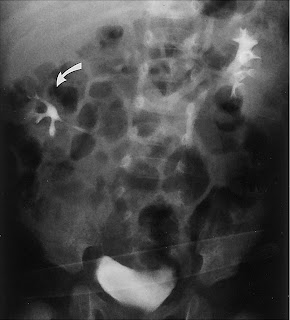 |
| Drooping lily. |
The drooping lily sign can be identified at excretory urography in patients with duplicated renal collecting systems. The sign consists of inferolateral displacement of a functioning lower pole moiety and lateral displacement of the most superior calices of the lower pole collecting system, usually by a nonopacified, hydronephrotic upper pole collecting system. The appearance of the lower pole collecting system is reminiscent of a lily flower that is wilting or drooping.
The drooping lily sign is due to inferior and lateral displacement of the lower pole moiety of a duplex kidney, rather than displacement of an entire kidney. An obstructed, poorly functioning upper pole moiety exerts a mass effect on the lower pole collecting system, which is responsible for the abnormal axis of the lower pole calices and which causes the droop of the lily. Because only the lower pole collecting system is opacified with intravenously administered contrast material, a decreased number of calices are depicted, as no calices extend cephalad from the renal pelvis.
The sign is often accompanied by a bladder filling defect, representing a ureterocele, which is associated with the ectopic insertion of the upper moiety ureter. As the frequency of excretory urography wanes, the “classic” drooping lily is less frequently encountered. Diagnostic consideration should be given to the presence of a duplication anomaly whenever a process is discovered in only one portion of a kidney.


No comments:
Post a Comment